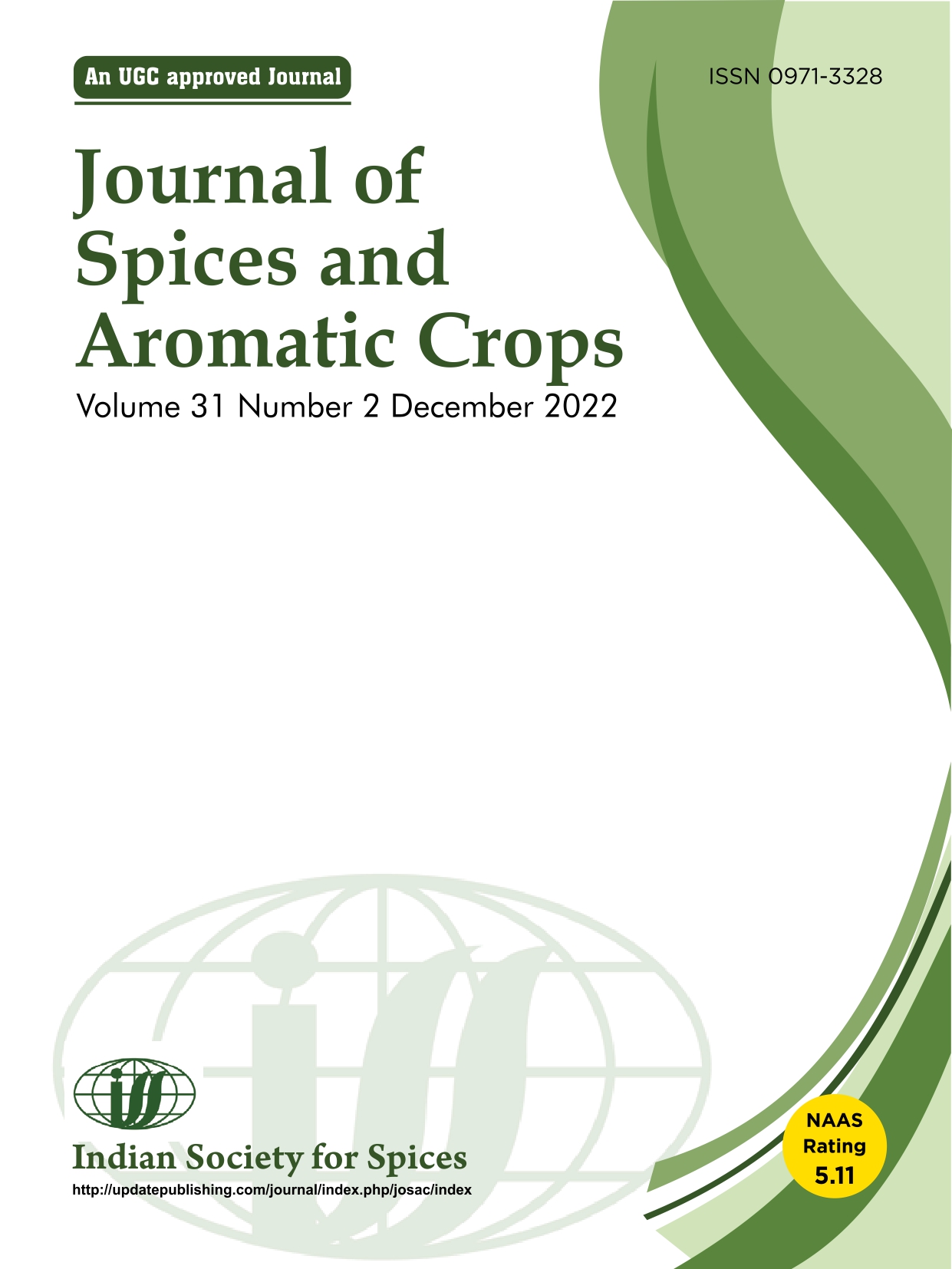Effect of low temperature grinding on phytochemicals profile of fenugreek seed powder
Effect of grinding methods on the quality of fenugreek seed powder
DOI:
https://doi.org/10.25081/josac.2022.v31.i2.7958Keywords:
antioxidant activity, fenugreek seed powder, low-temperature grinding, sotolone, total phenol, flavonoidAbstract
The grinding of spices at ambient temperature causes the loss of valuable heat-sensitive constituents. While higher investment and maintenance of cryogenic grinding make it prohibitive for small-scale industries. So, the present study was carried out to check the effects of low-temperature grinding on various phytochemicals of ground powder of fenugreek seeds. Water at ambient temperature, chilled water and coolant were circulated around the grinding chamber to lower the grinding temperature. Additionally, fenugreek seeds were fed at ambient and low temperatures (-100C). The temperature inside the grinding chamber at the end of grinding for three kg of fenugreek seeds ranged from 91.330C–53.330C for different treatments. A fall in grinding temperature resulted in the retention of a higher quantity of total phenol (7.71 mg g-1), total flavonoid (12.08 mg quercetin equivalent/g extract), antioxidant activity (21.29%) and volatile components in powder of fenugreek seeds ground by coolant circulation with low-temperature feed.
Downloads
References
Altuntaș E, Özgöz E & Tașer Ö F 2005 Some physical properties of fenugreek (Trigonellafoenum-graceum L.) seeds, J. Food. Eng. 71(1): 37–43.
Bano D, Tabassum H, Ahmad A, Mabood A & Ahmad IZ 2016 The medical significance of the bioactive compounds of Trigonellafoenum-graecum: a review. Int. J. Res. Ayurveda Pharm. 7(4): 84–91.
Blank I, Lin J, Devaud S, Fumeaux R & Fay LB 1997 The principal flavour components of fenugreek (Trigonellafoenum-graecum L.). In: Spices, (Risch et al., Eds.), ACS Symposium Series, American Chemical Society, Washington DC.
Bukhari S B, Bhanger M I & Memon S 2008 Antioxidative activity of extracts from fenugreek seeds (Trigonellafoenum-graecum). Pak. J. Anal. Environ. 9(2): 78–83.
Chaaban H, Ioannou I, Chebil L, Slimane M, Gérardin C, Paris C, Charbonnel C, Chekir L & Ghoul M 2017 Effect of heat processing on thermal stability and antioxidant activity of six flavonoids. J. Food Process. Preserv. 41(5).
Chandra Shekhar T & Anju G 2014 Antioxidant activity by DPPH radical scavenging method of Ageratum conyzoides Linn. leaves. Am. J. Ethno med. 1(4): 244–249.
Chang C, Yang M, Wen H & Chern J 2002 Estimation of total flavonoid content in propolis by two complementary colorimetric methods. J Food Drug Anal. 10: 178–182.
Cosme P, Rodríguez A B, Espino J & Garrido M 2020 Plant phenolics: bioavailability as a key determinant of their potential health-promoting applications. Antioxidants, 9(12): 1263.
Dixit P, Ghaskadbi S, Mohan H & Devasagayam T P A 2005 Antioxidant properties of germinated fenugreek seeds. Phytother Res. 19(11): 977– 983.
Fæste C K, Namork E & Lindvik H 2009 Allergenicity and antigenicity of fenugreek (Trigonellafoenum-graecum) proteins in foods. J. Allergy Clin. Immunol. 123(1): 187–194.
Guerra P V & Yaylayan V 2011 Thermal generation of 3-amino-4,5- dimethylfuran-2(5H)-one, the postulated precursor of sotolone, from amino acid model systems containing glyoxylic and pyruvic acids. J. Agric. Food Chem. 59(9): 4699–4704.
Leela N K & Shafeekh K M 2008 Fenugreek. In: Chemistry of Spices, (Parthasarathy et al., Eds.), CAB International, Wallingford, UK.
Malick C P & Singh M B (Eds.). 1980 Plant enzymology and histo enzymology (pp. 286). Kalyani Publishers, New Delhi.
Mandegary A, Pournamdari M, Sharififar F, Pournourmohammadi S, Fardiar R & Shooli S 2012 Alkaloid and flavonoid rich fractions of fenugreek seeds (Trigonellafoenum-graecum L.) with antinociceptive and anti-inflammatory effects. Food Chem. Toxicol.50 (7): 2503–2507.
Mebazaa R, Mahmoudi A, Fouchet M, Dos Santos M, Kamissoko F, Nafti A, Ben Cheikh R, Rega B & Camel V 2009 Characterisation of volatile compounds in Tunisian fenugreek seeds. Food Chem. 115(4): 1326–1336.
Meghwal M & Goswami T K 2012 A review on the functional properties, nutritional content, medical utilization and potential application of fenugreek. J. Food Process. Technol. 3(9): 1–10.
Nair S, Nagar R & Gupta R 1998 Antioxidant phenolics and flavonoids in common Indian foods. J Assoc Physicians India. 46(8): 708– 710.
Panche A N, Diwan A D & Chandra S R 2016 Flavonoids: an overview. J. Nutr. Sci. 5. E47.
Pruthi J S & Mishra B D 1963 Physical, chemical and microbial changes in curry powders during drying, milling and mixing operations. Spice Bulletin, 3: 9–13.
Rao P U, Sesikeran B, Rao P S, Naidu A N, Rao V V & Ramachandran E P 1996 Short term nutritional and safety evaluation of fenugreek. Nutr Res. 16(9): 1495–1505.
Sheoran, O P, Tonk, D S, Kaushik L S Hasija R C & Pannu, R S 1998 Statistical Software Package for Agricultural Research Workers. Recent Advances in information theory, Statistics & Computer Applications by D.S. Hooda & R.C. Hasija Department of Mathematics Statistics, CCS HAU, Hisar, 8(12): 139–143
Shiva K N & Malhotra S K 2008 Fenugreek In: Organic Spices, New India Publishing Agency, Pitam Pura, New Delhi, India.
Singh K K & Goswami T K 1999 Design of a cryogenic grinding system for spices. J. Food Eng. 39(4): 359–368.
Sulaiman C T & Balachandran I 2012 Total phenolics and total flavonoids in selected Indian medicinal plants. Indian J. Pharm. Sci. 74(3): 258–260.
USDA 2019 Spices, fenugreek seed (SR Legacy, 171324), Food Data Central, From Agricultural Research Service (ARS), United States Department of Agriculture (USDA), U.S. Federal Government, USA.
Yadav R, Kaushik R & Gupta D 2011 The health benefits of trigonellafoenu mgraecum: a review Int J Eng Res Appl. 1(1): 32–35.
Yashin A, Yashin Y, Xia X &Nemzer B 2017 Antioxidant activity of spices and their impact on human health: a review. Antioxidants, 6(3):70.
Zandi P, Basu SK, Cetzal-Ix W, Kordrostami M, Chalaras SK & Khatibai LB 2017 Fenugreek (Trigonellafoenum-graecum L.): an important medicinal and aromatic crop. In: Active Ingredients from Aromatic and Medicinal Plants, (El-Shemy, Ed.), In Tech, Rijeka, Croatia, pp.217–223.
Published
How to Cite
Issue
Section
Copyright (c) 2023 Prakash M Sirwani, Mukesh N Dabhi, Pankaj J Rathod

This work is licensed under a Creative Commons Attribution-NonCommercial-NoDerivatives 4.0 International License.






 .
.